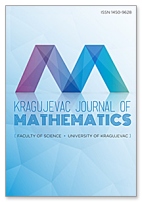On Commutativity Degree of Crossed Modules
 Download PDF
Download PDF
Authors: S. AMINI, S. HEIDARIAN AND F. K. HAGHANI
DOI: 10.46793/KgJMat2405.713A
Abstract:
In this paper, we define and study the notion of commutativity degree of finite crossed modules. We shall state some results concerning commutativity degree of crossed modules and obtain some upper and lower bounds for commutativity degree of finite crossed modules. Finally we show that, if two crossed modules are isoclinic, then they have the same commutativity degree.
Keywords:
Crossed module, commutativity degree, isoclinism.
References:
[1] F. Barry, D. MacHale and Á. Ní Shé, Some supersolvability conditions for finite groups, Math. Proc. R. Ir. Acad. 106A(2) (2006), 163–177.
[2] B. Edalatzadeh, Universal central extensions of lie crossed modules over a fixed lie algebra, Appl. Categ. Structures 27 (2019), 111–123. https://doi.org/10.1007/s10485-018-9545-z
[3] P. Erdös and P. Turán, On some problems of a statistical group-theory IV, Acta Math. Hungar. 19 (1968), 413–435.
[4] A. Erfanian, R. Rezaei and P. Lescot, On the relative commutativity degree of a subgroup of a finite group, Comm. Algebra 35(12) (2007), 4183–4197. https://doi.org/10.1080/00927870701545044
[5] W. H. Gustafson, What is the probability that two group elements commute? Amer. Math. Monthly 80 (1973), 1031–1034. https://doi.org/10.2307/2318778
[6] P. Hall, The classification of prime-power groups, J. Reine Angew. Math. 182 (1940), 130–141. https://doi.org/10.1515/crll.1940.182.130
[7] P. Lescot, Central extensions and commutativity degree, Comm. Algebra 29(10) (2001), 4451–4460. https://doi.org/10.1081/agb-100106768
[8] P. Lescot, Isoclinism classes and commutativity degrees of finite groups, J. Algebra 177(3) (1995), 847–869. https://doi.org/10.1006/jabr.1995.1331
[9] K. J. Norrie, Crossed modules and analogues of group theorems, PhD thesis, King’s College, University of London, 1987.
[10] A. Odabas, E. Ö. Uslu and E. Ilgaz, Isoclinism of crossed modules, J. Symbolic Comput. 74 (2016), 408–424. https://doi.org/10.1016/j.jsc.2015.08.006
[11] M. R. Pournaki and R. Sobhani, Probability that the commutator of two group elements is equal to a given element, J. Pure Appl. Algebra 212(4) (2008), 727–734. https://doi.org/10.1016/j.jpaa.2007.06.013
[12] H. Ravnbod and A. R. Salemkar, On stem covers and the universal central extensions of lie crossed modules, Comm. Algebra 47(7) (2019), 2855–2869. https://doi.org/10.1080/00927872.2018.1541461
[13] H. Ravanbod, A. R. Salemkar and S. Talebtash, Characterizing n-isoclinic classes of crossed modules, Glasg. Math. J. 61 (2019), 637–656. https://doi.org/10.1017/S0017089518000411
[14] D. J. Rusin, What is the probability that two elements of a finite group commute? Pacific J. Math. 82(1) (1979), 237–247.
[15] A. R. Salemkar, H. Mohammadzadeh and S. Shahrokhi, Isoclinism of crossed modules, Asian-Eur. J. Math. 9(3) (2016), Article ID 1650091. https://doi.org/10.1142/S1793557116500911
[16] Z. Sepehrizadeh and M. R. Rismanchian, On the characteristic degree of finite groups, J. Algebr. Syst. 6(1) (2018), 71–80. https://dx.doi.org/10.22044/jas.2018.6328.1316
[17] J. H. C. Whithead, On operators in relative homotopy groups, Ann. of Math. 49 (1948), 610–640. https://doi.org/10.2307/1969048
[18] M. Yavari and A. Salemkar, The category of generalized crossed modules, Categ. Gen. Algebr. Struct. Appl. 10(1) (2019), 157–171. http://dx.doi.org/10.29252/cgasa.10.1.157
